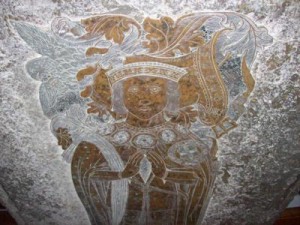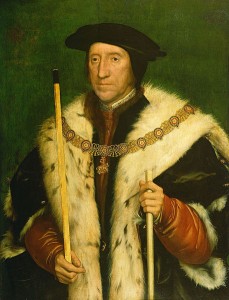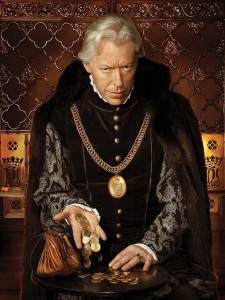
The intention of this article is not to criticise anyone who holds the view that the Boleyns used their daughters in that way, it is simply to argue that the historical evidence does not back up that view. The picture of a greedy and ambitious Thomas Boleyn and his like-minded brother-in-law, Thomas Howard, 3rd Duke of Norfolk, pimping out Mary and Anne Boleyn to the King for their own gain makes for good fiction, but it does not appear to be an accurate depiction. I have been researching the Boleyns for over five years now and the primary sources paint a very different picture of Thomas Boleyn to the one we see in fiction and on TV.
There’s no doubt that Thomas Boleyn was an ambitious man, and that he was ambitious for his children too. He gave Anne the fantastic opportunity of receiving an education at the court of Margaret of Austria in Mechelen and then was able to get her and her sister chosen to attend Mary Tudor, Henry VIII’s sister, in France. These were amazing opportunities for a courtier’s daughter and the humanist Thomas Boleyn seems to have been similar to Thomas More and Sir Anthony Cooke in believing that daughters should receive the type of education which was usually reserved for sons. Boleyn was definitely a Renaissance man who embraced new ideas, such as humanism and the new religious views which were sweeping through Europe. Of course, such an education, and foreign travel to boot, along with her family’s wealth and connections, and her father’s closeness to the King, would have made Anne quite a catch in the marriage department and that’s what every Tudor man wanted for his daughter: a good marriage.

With regards to Anne, we don’t know exactly when Henry VIII noticed Anne and started courting her, but it appears to have been around 1526 and after negotiations for a marriage match between her and James Butler, a relation on her father’s side, had fizzled out. Again, we have no evidence of any involvement from Thomas Boleyn or the Duke of Norfolk in getting the King to notice Anne or of them doing anything to manipulate the situation in any way. There is, in fact, evidence that Thomas Boleyn was not keen on the idea of Anne marrying the King. Chapuys reported in February 1533, before he had heard news of the King’s marriage to Anne:
“I must add that the said earl of Wiltshire [Thomas Boleyn] has never declared himself up to this moment; on the contrary, he has hitherto, as the duke of Norfolk has frequently told me, tried to dissuade the King rather than otherwise from the marriage.”1
Chapuys went on to say:
“Shortly after the Duke [Norfolk] began to excuse himself and say that he had not been either the originator or promoter of this second marriage, but, on the contrary, had always been opposed to it, and tried to dissuade the King therefrom. Had it not been for him and for the father of the Lady, who feigned to be attacked by frenzy to have the better means of opposing it, the marriage would have been secretly contracted a year ago; and for this opposition (the Duke observed) the Lady had been exceedingly indignant with the one and the other.”2
So, the Duke of Norfolk gave Chapuys the idea that he and Thomas Boleyn were against the marriage and that Anne had been cross with them about it. This does not support the idea of poor little Anne being pushed into marriage with the King against her will.

Even if you take 1519 as a likely date for Mary Boleyn’s affair with Henry VIII, which would fit in with Elizabeth Blount’s pregnancy and Mary Boleyn’s marriage to William Carey in 1520, Thomas Boleyn was already an important man and a man in favour – he was the English ambassador at the French court, he was a member of the Privy Council, he owned over 20 manors, he’d acted as a canopy bearer at the christening of Princess Mary and Queen Margaret of Scotland’s official carver for the forty days of her visit to England, he’d served as Keeper of the Exchange at Calais and the Foreign Exchange in all English ports, and that’s just picking a few things from his early career at court. In his thesis on Thomas Boleyn, William Dean said: “One cannot, as some have done, simply attribute Boleyn’s advancement to Henry’s preferment of his daughters up to this point. Granted, a case may be made for this influence later, but Henry had no history of doing generous things for his mistresses, much less their parents. It is more likely that Henry recognised ability and past service and rewarded Boleyn for it” and I agree with him wholeheartedly.3 Thomas Boleyn was a talented man and certainly had no need to pimp out his daughters for favour and advancement, he already had both.
One person on Facebook commented that unless she saw hard evidence that Thomas had nothing to do with it and that he did not profit from the marriage of his daughter to Henry VIII then she would have to disagree that Thomas was a wonderful person. Well, it’s hard to prove a negative but I like to give people the benefit of the doubt and see them as innocent until proven guilty. We have no evidence that Thomas forced his daughters into their relationships with the King so surely he should be given the benefit of the doubt. As for him being a wonderful person, I don’t think I could ever argue that because I don’t know enough about his personality. He certainly had very good relationships with those around him and was well respected by the likes of Margaret of Austria (she made a wager with him and offered Anne a place at her court), the French royal family, Cardinal Wolsey, Henry VII, Margaret Tudor and Henry VIII. What we can say is that he was talented, hardworking and had an incredible career.
As for him abandoning his son and daughter to their awful fates in 1536, we don’t know what happened there either. We know that he was on the commission which tried William Brereton, Henry Norris, Francis Weson and Mark Smeaton, and which of course prejudiced Anne’s trial, but he would have had little choice in that. There’s no evidence that he did anything to try and save Anne and George, but that doesn’t mean that he didn’t write to Cromwell or the King, it just means that we don’t have the letter. He would, however, have known from experience that there was no hope for them, and retiring to Hever to be with his wife may have been the most sensible thing to do at that time. He lost his office of Lord Privy Seal in June 1536 but he did what all families did when they had been tainted by treason and lost loved ones to the executioner, he dusted himself off, put his surviving family first and went about proving his loyalty to the King. He helped put down the Pilgrimage of Grace rebellion in late 1536 and had managed to climb back enough into the ing’s favour to be present at Prince Edward’s baptism in October 1537. Historian Eric Ives describes how he diligently went to Order of the Garter functions, even lending Thomas Cromwell, his chain and best Garter badge at one point, and how he was back at court by January 1538.4 It was even rumoured in July 1538, following the death of Elizabeth Boleyn in the April, that he was going to marry Margaret Douglas, the King’s niece!5 Does that mean that he forgot what had happened to his children? Did it mean that he was heartless? No, of course not, we cannot know how he felt about any of it, he was simply a man of his time and he would have known that his family’s survival depended on him moving on, just as the Stafford, Dudley and Howard families did.
Thomas Boleyn died on the 12th March 1539 at his home, Hever Castle, aged around sixty-two. He was laid to rest in a tomb in the family church of St Peter’s in Hever, Kent, and Henry VIII ordered masses to be said for his soul, showing that Thomas was truly back in favour with the King at the time of his death.6
If we defend Anne Boleyn and give her the benefit of the doubt, because the evidence does not support the idea that she was guilty, then can’t we extend the same courtesy to her family? It’s all too easy to paint her as the victim of an ambitious and manipulative family, but that surely is doing a disservice to all of the Boleyns. Anne’s innocence does not have to be at the cost of her family’s reputation.
You can see a list of Thomas Boleyn’s grants, offices and titles between 1501 and 1521 in my article In Defence of Thomas Boleyn.
On this day in history…
- 1514 – Marriage of Mary Tudor, sister of Henry VIII, and Louis XII of France – click here to read more.
Notes and Sources
- Span. Cal. iv. ii.1048
- Span. Cal. iv. ii.1077
- Sir Thomas Boleyn: The Courtier Diplomat, 1477-1539, William Hughes Dean, Ph.D., West Virginia University
- Eric Ives (2004) The Life and Death of Anne Boleyn, 353
- LP xiii. Part 1. 1419
- LP xiv. 950